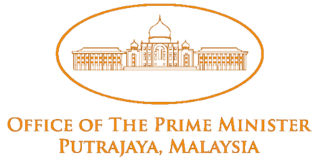
The prime ministerof Malaysia is the head of government of Malaysia. The prime minister directs the executive branch of the federal government. The Yang di-Pertuan Agong appoints the prime minister as a member of Parliament (MP) who, in his opinion, is most likely to command the confidence of a majority of MPs. The prime minister is usually the leader of the party winning the most seats in a general election.
In Malaysia, the Menteri Besar, colloquially referred to as MB, is the head of government of each of nine states in Malaysia with monarchs. For four states without a monarch, the title Chief Minister, is used except for Sarawak where it uses Premier (Premier). The title "Menteri Besar" is usually untranslated in the English media in Malaysia, but is typically translated as 'Chief Minister' by foreign media. According to protocol, all Menteris Besar, Chief Ministers and Premier are styled Yang Amat Berhormat, which means "The Most Honourable".

The chief minister of Penang is the head of government in the Malaysian state of Penang. According to convention, the chief minister is the leader of the majority party or largest coalition party of the Penang State Legislative Assembly. The chief minister's official residence is Seri Teratai in the capital city of George Town.
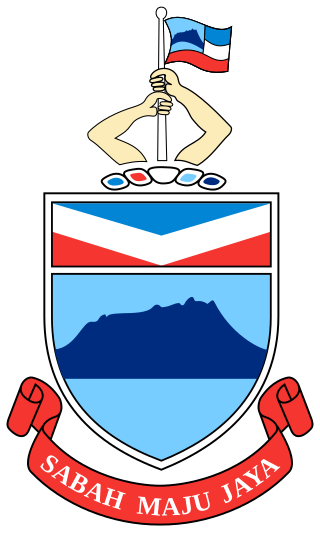
The chief minister of Sabah is the head of government of Sabah, Malaysia. Since September 2020, the position has been held by Hajiji Noor from the Parti Gagasan Rakyat Sabah from the coalition of Gabungan Rakyat Sabah (GRS) which had won the 2020 Sabah state election. As in other parts of the Malaysian federation, the Westminster Parliamentary system is adopted, whereby, the leader of the party with the most seats in the state legislature would usually become the chief minister of Sabah. In other words, it is the person commanding the support of the state legislature. The chief minister is appointed by the head of state known as the Yang di-Pertua Negeri. In comparison to other states in Malaysia, the office of the chief minister of Sabah has been held by a more diverse group of people in terms of ethnicity and religion. The post has been held by Kadazan-Dusuns, Bajaus, Malays, Chinese, Muruts, Rungus, Sungai, Idaans, and other persons of mixed heritage as well as being Muslims, Buddhists and Christians.

The Menteri Besar of Selangor, also referred to as the First Minister of Selangor is the head of government in the Malaysian state of Selangor. The Menteri Besar acts as a majority leader in the Selangor Assembly. According to convention, the Menteri Besar is the leader of the majority party or largest coalition party of the Selangor State Legislative Assembly.

The Menteri Besar of Kedah or the First Minister of Kedah is the head of government in the Malaysian state of Kedah. According to convention, the Menteri Besar is the leader of the majority party or largest coalition party of the Kedah State Legislative Assembly.

The Menteri Besar of Perak or First Minister of Perak is the head of government in the Malaysian state of Perak. According to convention, the Menteri Besar is the leader of the majority party or largest coalition party of the Perak State Legislative Assembly.
The 2009 Perak constitutional crisis was a political dispute in Malaysia over the legitimacy of the Perak state government formed in February 2009. It began when three Pakatan Rakyat state legislators defected, causing a collapse of the state government. The Sultan of Perak then refused First Minister Mohammad Nizar Jamaluddin's request to dissolve the state assembly and call elections. Instead, the Barisan Nasional (BN), with support from the three defecting assemblymen, formed the new state government.
Mohammad Nizar Bin Jamaluddin v Zambry Bin Abd. Kadir was a case decided in the High Court of Kuala Lumpur, Malaysia. The case was brought by Menteri Besar of Perak state, Mohammad Nizar Jamaluddin, against Zambry Abdul Kadir, who acted as Menteri Besar after three members of the state legislative assembly defected from Nizar's Pakatan Rakyat and threw their support behind Zambry's Barisan Nasional coalition. The subsequent confusion and controversy regarding the state government resulted in the 2009 Perak constitutional crisis. In his judgment handed down on 11 May 2009, Justice Abdul Aziz Abdul Rahim ruled that Nizar was and had always been the rightful Menteri Besar, and ordered Zambry to immediately cease acting as Menteri Besar. The Court of Appeal granted a stay of execution of the High Court's order the following day, further confusing the situation.

The Kelantan State Legislative Assembly is the unicameral state legislature of the Malaysian state of Kelantan. It consists of 45 members representing single-member constituencies throughout the state. Elections are held no more than five years apart.
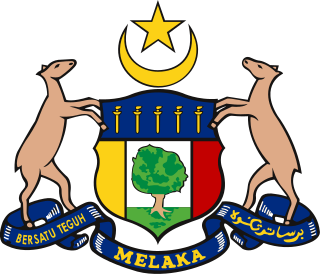
The Chief Minister of Malacca is the head of government in the Malaysian state of Malacca. According to convention, the chief minister is the leader of the majority party or largest coalition party in the Malacca State Legislative Assembly. The position has been held by Ab Rauf Yusoh since 31 March 2023.

The Menteri Besar Pahang or First Minister of Pahang is the head of government in the Malaysian state of Pahang. According to convention, the Menteri Besar is the leader of the majority party or largest coalition party of the Pahang State Legislative Assembly.

The Menteri Besar of Negeri Sembilan or First Minister of Negeri Sembilan is the head of government in the Malaysian state of Negeri Sembilan. According to the convention, the Menteri Besar is the leader of the majority party or largest coalition party of the Negeri Sembilan State Legislative Assembly.
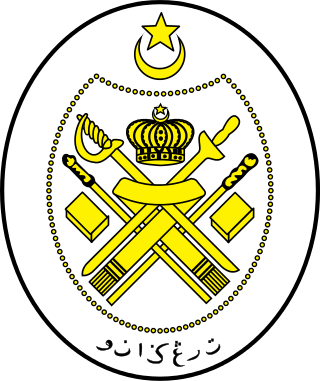
The Menteri Besar of Terengganu or First Minister of Terengganu is the head of government in the Malaysian state of Terengganu. According to convention, the Menteri Besar is the leader of the majority party or largest coalition party of the Terengganu State Legislative Assembly.

The Menteri Besar of Perlis or First Minister of Perlis is the head of government in the Malaysian state of Perlis. According to convention, the Menteri Besar is the leader of the majority party or largest coalition party of the Perlis State Legislative Assembly.

The Menteri Besar of Johor or Chief Minister of Johor is the head of government in the Malaysian state of Johor. According to convention, the Menteri Besar is the leader of the majority party or largest coalition party of the Johor State Legislative Assembly.
The 14th Kelantan State election was held on 9 May 2018, concurrently with the 2018 Malaysian general election. The previous state election was held on 5 May 2013. The state assemblymen is elected to 5 years term each.
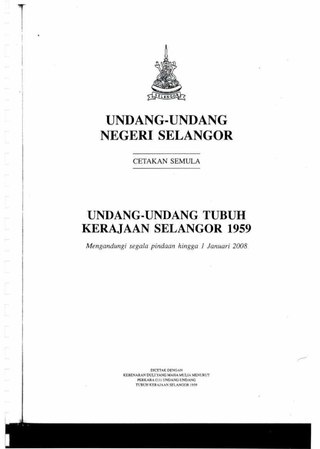
The Laws of the Constitution of Selangor 1959 is the fundamental law of the state of Selangor and establishes the state as a constitutional monarchy with the Sultan of Selangor as the Head of State. It came into force in April 1959 following the independence of Federation of Malaya in 1957.
The 13th Selangor state election was held on 5 May 2013. The Selangor State Legislative Assembly would automatically dissolve on 22 April 2013, the fifth anniversary of the first sitting, and elections must be held within sixty days of the dissolution; on or before 22 June 2013, with the date to be decided by the Election Commission of Malaysia, unless dissolved prior to that date by the Head of State, Sultan of Selangor on the advice of the Head of Government, Menteri Besar of Selangor.
The Selangor state government refers to the government authority of the Malaysian state of Selangor. The state government adheres to and is created by both the Malaysian federal Constitution, the supreme law of Malaysia, and the Constitution of the State of Selangor, the supreme law in Selangor. The government of Selangor is based in the state's capital city of Shah Alam.





















